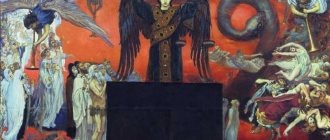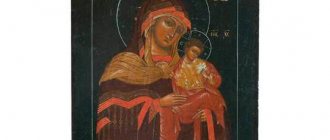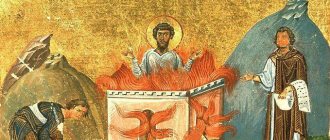Bible Questions and Answers
Published 03/14/2021
Who is the devil (Satan) and where did he come from? What does the Bible say about the devil? When one of the people decides to commit a sin - to steal, for example, is it the devil who provokes him to do this?
Is it true that the Hebrew word used for "Satan" in the Bible is different from the word used for "devil" in the New Testament? Some believe that the devil and Satan are two different beings. Unfortunately, the Bible gives very little information about Satan.
Who is the devil?
Today the church has lost its former influence. People are no longer so religious and, as a result, they lose faith in God. It may seem surprising to some that belief in the devil continues to live among the people. Good things are always hard to believe, but bad things are easy to believe. Does the devil exist and who is he? More than one generation of people has been looking for answers to these questions. According to the Bible, the devil is a fallen angel expelled from heaven. Why was he expelled? The devil was selfish and very ambitious. A sort of careerist, in modern terms. God will not like the tough temper of his subordinate, and he decided to show who is the boss in heaven. As a result, God won and the devil was defeated. The devil fell along with his like-minded people. Fallen angels are servants of dark forces. Whether there is a devil in the world is impossible to say. Why? For the reason that no one knows what he looks like. But people like to speculate about this.
The Birth of the Modern Satan
Characteristics: Red with hooves and horns, partly developed from deities of other religions.
The vaguely defined Satan of the Old Testament gradually transformed during the early Christian period, the Middle Ages and the Renaissance into the demonic Archdemon who rules over Hell. This Satan is well known in the modern era - a vengeful, proud fallen angel who tempts to sin and condemns to fight with God for the fate of mortal souls. Many factors and writings created this mythological Satan:
- The creation of the English King James Bible in 1611 turned "Lucifer", the Latin term for, into a proper name and associated him with a satanic figure. This helped personify Satan as an individual being.
- When Christianity replaced existing religions, the gods of other religions were often denounced as demons. As the ruler of all demons, Satan then began to take on aspects of these demonized deities. Satan appropriated for himself the cloven hooves and horns of the Greek god Pan, and the insatiable nature of the Roman god Bacchus (Dionysus).
- Writers and religious authorities during the Middle Ages and the Renaissance expanded Christian mythology, creating stories that became crucial to Christian thought and identity, despite not appearing in the Bible. John Milton's epic poem Paradise Lost and Dante Alighieri's The Divine Comedy are among the iconic works of this type. Paradise Lost in particular created a complex mythology, including the rebellion of angels, and the powerful image of Lucifer being cast out of heaven for his pride and refusal to obey God.
But there is one more step in the evolution of Satan. During the Age of Enlightenment
, around the 18th century, scientific and rational thought took a more prominent place in European society. Satan has evolved from a force of pure evil to a more symbolic being with even positive qualities. He became a proud figure, unwilling to submit to tyranny.
What does the devil look like?
Just because something can't be seen is no reason not to think about what something unseen might look like. Since ancient times, people have wondered whether the devil exists. Therefore, today there are many assumptions regarding its appearance. The Bible says that the devil was handsome and strongly built. But people did not like this idea of evil. You always want evil to look repulsive. Therefore, smart ancestors decided that the devil could change his appearance at will. He may appear to some people in the form of a serpent, to others in the form of a dragon, and to others in the form of a man. But how then can you recognize the devil if his appearance is so diverse? A person can only rely on his instincts and intuition. You can unravel the dark otherworldly force by speeches and by the beliefs that it will inspire.
Origin of Satan
The image, character, and definition of Satan have evolved greatly over the years.
To understand Satanists, we must first understand Satan. Just like the fictional characters Doctor Strange or Lex Luthor, Satan has an origin story.
The first mention of Satan appears in the Hebrew Bible (Tanakh), from which most of the Christian Old Testament is derived. However, there is great uncertainty among religious scholars as to what the authors meant when the word "Satan" appears in the Old Testament. The definition may vary depending on how the biblical term for Satan (שָּׂטָן) is translated and interpreted. In some cases the term simply means "adversary" and clearly indicates a human figure rather than a supernatural one. At other times he suggests that Satan is the "accuser" or part of Heaven's legal system. There is no consensus that Satan is a type of any person, or would refer to a supernatural being who is the enemy of God. Although the concept has taken various forms over the centuries, the idea of Satan as an outsider who opposes established values is a common thread that runs through all of his incarnations.
The Christian New Testament contains a much clearer evolution of Satan as the one supernatural evil in opposition to God. He often appears at the will of God to test people so that they show their true faith.
However, even in the New Testament there is a lot of confusion about who Satan is. Scholars should carefully study the various translations of Hebrew and Aramaic words for "evil" or the names of certain demons, such as Abaddon, Beelzebub, or Belial , and try to explain whether they refer to Satan or more general evil in context. When looking solely at the Bible, it is difficult to determine what Satan looks like, where he comes from, or what his goals are.
So, where did the horned, pitchfork version of Satan come from?
The Devil's Purpose
If we assume that a dark otherworldly force exists, the question involuntarily arises: “Why is it needed?” Whether the devil exists or not, there is definitely evil in the world. People always like to look for someone to blame for their problems and misfortunes. The devil has become such a scapegoat for many. Our ancestors blamed him for all their sins. For example, someone decided to cheat on his wife. It is much easier to explain your action by saying that the devil led you astray from the right path than to openly admit your decision to go to the left. The same applies to negative human qualities. A greedy person, having lost his savings, will say that all problems are due to the devil. And no one is used to taking their own vices into account. So the purpose of the devil in our world is simple. People blame their troubles, bad deeds, negative character traits and their own mistakes on an otherworldly being.
Bipha-mother Baphomet
The 19th century French occultist Alphonse-Louis Constant Eliphas Levi summarized many of the disparate symbols of Satan the Devil into a generally accepted visual image. He depicted something named “Baphomet”:
Here we see the symbols of the ancient Father-Creator “condemned” thousands of years ago (fire, horns and phallus) and many symbols of the Great Mother (darkness, night, moon, female organs, snakes, fish scales (water element)). Perhaps the scales can symbolize not just a fish, but a water monster - a dragon, which itself is one of the names and images of Satan the devil. In the Revelation of John the Evangelist (Apocalypse), Satan is called the Great Red Dragon or Great Dragon. Among the main “female” symbols, only the symbol of the earth is missing, although perhaps the ball on which this something sits symbolizes the earth (the globe). The five-pointed star (pentagram) is the Mesopotamian star of Inanna (Astarte), which at the same time symbolizes her womb (you can read a separate article about this).
It is characteristic that the name Baphomet, which first appeared in medieval records, originally referred to the wife of Satan, the “damned she-devil.” And this is very remarkable, since in this case the name itself is deciphered in no other way than a cow, wife or mother of a bull - Bifa-mother (compare, for example, with the name of the Mesopotamian goddess Tiamat). In English and German beef (beef), in French boeuf (boeuf). And the word beef itself, through the word “bull,” is connected with the name Baal.
In other words, in the image of the devil-Satan, which has developed at the moment in popular culture, the symbolic attributes of the pre-monotheistic stereotheistic divine pair of male and female principles are encrypted. Moreover, with an overwhelming preponderance towards the feminine. That is, we can say that the modern image of Satan the devil encrypts precisely the distorted image of the ancient Great Mother (matter), through which the Father-Creator (spirit) created the world. And this is quite logical, considering that Satanists are precisely nostalgic (at least in the “masterpieces” of their “art”) for the old pre-monotheistic late pagan orgiastic bloody cults. These cults had an overwhelming bias precisely towards the feminine principle, which is precisely why in monotheism it was subjected to such uncompromising oblivion, from the thousand-year prison of which it is breaking free in the conditions of today’s weakening of monotheism.
The connection between the nature of Satan the devil and the feminine principle in culture is also indicated by the medieval Kabbalistic addition to the story of Adam and Eve in the form of Lilith, who is the tempting snake. The image of Lilith goes deep into Mesopotamian beliefs and is associated with Belit, Astarte and Inanna, successive historical images of the ancient stereotheistic Great Mother.
Other confirmations of the assumption of the connection between Satan the devil and the feminine principle are, firstly, the clear orientation of the modern urban capitalist civilization of Western post-Christian countries towards materialism , that is, towards the area that has always been the hypostasis of the Great Mother ( matter , money, material well-being, comfort and pleasure ), secondly, the obvious hostility of this urban civilization towards the religions of the Father-Creator (Judaism, Christianity and Islam) - this is how the image of the Great Mother “takes revenge” for its oblivion during the reign of monotheism.
Are the devil and evil forces the same thing?
Our ancestors are accustomed to believing that the world is filled with invisible creatures. And each of them was responsible for one or another area of activity. Thinking about whether the devil really exists, people decided that he does. If there was a God, then there was a devil. This creature still lives among us and tempts good citizens. The devil is considered the representative of all evil forces. No matter what bad happens to a person, he sincerely believes that it is the work of the devil. Stupid? Maybe. With the fall of church power over the minds of citizens, people stopped believing in religious superstitions. There is no argument in scripture, and everything has to be taken on faith. Modern man does not intend to make such an agreement. Therefore, today you can increasingly hear the opinion that the devil does not exist, and evil forces are nothing more than negative energy that a person has earned for himself by committing certain sins.
Satanism and Witchcraft in the Middle Ages
Witches burned in the Middle Ages were often accused of Satanism or devil worship.
Two types of people were accused of worshiping Satan in the Middle Ages and the Renaissance: witches and Western esotericists. Late 15th century treatise on witchcraft, Malleus Maleficarum
", aka
"The Hammer of the Witches" , followed the example of modern culture, labeling everything that contradicts Orthodox Christianity as the worship of Satan.
It contained sections condemning witches for their lack of belief in demonology and sexual relations with devils. And groups like the Cathars were considered heretics and persecuted by the Church for their veneration of satanic figures. Despite the accusations, there is no hard evidence that organized groups worshiped Satan as an evil deity during the Middle Ages or the Renaissance. And the existence of some supposedly devil-worshipping groups, such as the Luciferians, is debated and often discredited. Were there actually organizations, covens, or cults that regularly worshiped Satan during this time? The answer is probably not.
For a longer answer, let's start with witches . During the 16th and 17th centuries, widespread witch panics in Europe reached their peak. An estimated 60,000 people in Europe and the American colonies were sentenced to death for the crime of witchcraft, almost all of them women. This witchcraft hysteria was widely exported to the United States through Salem, Massachusetts in 1692. The vast majority of these cases were the result of petty grievances, childhood accusations, or social punishments. Some of the "witches" involved in this case practiced old pagan traditions or folk magic, or were simply not pious enough in the eyes of the local community. The negative image of the witch, as evil, as deviant, was created by the Christian church with the help of the secular ruling class. The "One True Church" was supposed to eliminate competition.
In addition, there are esoteric orders
or groups that held non-Christian ideas or adopted occult practices from other religions. These included groups professing Gnosticism, Kabbalah, Christian Theosophy and Rosicrucianism. What they all had in common was the idea that hidden (occult) truths could be found in the world or in sacred texts, and church members could learn rituals that unlocked secret powers.
The esoteric orders were not overtly satanic. However, the mainstream church portrayed them as evil and satanic in order to undermine them and reduce their appeal, much as they did with displaced religions in earlier eras. For example, in the 14th century, in a power struggle between church authorities and the Christian military order of the Knights Templar, the leaders of the knights were arrested and accused of spitting on the cross and worshiping an idol called Baphomet.
The inherent secrecy of these groups made them vulnerable to accusations of blasphemy and Satan worship. Members of these orders may have been branded as evil heretics and blasphemous devil worshipers, but it is unlikely that there were any long-term organized groups of Satanists who actively worshiped Satan as an evil entity in any historical era. Even today, secret societies and esoteric orders such as the Illuminati and Freemasons are at the center of many sinister conspiracy theories. However, there is a plot twist here: modern Satanist groups have adopted many supposedly Satanic symbols, such as the inverted pentagram and the image of the deity Baphomet, used by esoteric orders.
However, it is time to meet Anton LaVey, the father of modern Satanism.
Is it possible to sell your soul to the devil?
There is an opinion that overly successful, beautiful or talented people make deals with evil forces in order to become famous. Is it so? People have been arguing for a long time whether God and the devil exist, but they have not yet been able to come to a consensus. Accordingly, get an answer to the question: “Is it possible to sell your soul to someone?” also impossible. Have you ever wondered if you would sell your soul if given the opportunity? Most likely no. So why does it seem that every talented person is in a deal with the devil? Human envy is limitless. Sometimes it is difficult for a person to explain to himself why his neighbor is doing well and he is doing poorly. People only see what they want to see. Sometimes a person simply does not want to notice the fact that his neighbor works hard and hard in order to get some material benefits and a promotion. Rarely does something come easy to a person. Basically, you have to spend a lot of energy and health to achieve the desired result. It is for this reason that when a person earns his first million, his health is poor and he has many psychological problems. But there can be no talk of any kind of deal here. The person simply set his priorities incorrectly at the time.
Satan Temple and other Satanic practices
Satanic Temple spokesman Lucien Greaves stands in front of a statue of Baphomet.
The Satanic Temple is a loosely organized group of Satanists similar to the Church of Satan, but it does not support a hardline version of Satanism. The temple is also home to atheists, philosophical Satanists. However, he rejects Social Darwinism and the libertarian views of the Church of Satan. The beliefs of Satanic Temple adherents are similar to those of secular humanists, who value critical, scientific thinking and individualism.
The temple is politically and socially progressive and uses its notoriety to achieve progressive causes. For the Satanic Temple, the shock value of Satanic imagery is useful as a media and political tool, and the organization regularly uses it to counterbalance what it sees as religious intrusions into public life. For example, the temple requested that a statue of Baphomet be placed next to the Ten Commandments monument on the Oklahoma State Capitol grounds in 2015.
Als Young, a San Francisco Satanist and member of the Satanic Temple (though not an official spokesman), described his interest in the Temple as a conscious rejection of LaVeyan Satanism. “I learned about the Satanic Temple through a public flap about the Baphomet monument in Oklahoma, like most people, I found their example refreshing,” Young said via email.
There are several lesser-known satanic groups. The First Satanic Church, founded by Anton LaVey's daughter Carla LaVey, is an offshoot of the Church of Satan. The Order of the Serpent is another group that follows the "left hand path". Modern esoteric and occult groups such as the Temple of Set are sometimes confused with satanic organizations. A handful of satanic groups mainly in Europe, such as the Order of Nine Angles, are associated with far-right nationalist ideologies.
Finally, there are theistic Satanists, or those who worship Satan as a deity rather than symbolically. Theistic Satanists do not have widespread organizations, and some atheistic Satanists do not approve of their Satanic label. Of the few theistic Satanists, none of them worship a literal, supernatural Satan as God, as the Satanists in the films do.
Some of them worship Satan as a pagan deity, but not as the embodiment of evil. A Satanist from Sao Paulo, Brazil, considers Satan to be a deity, but describes beliefs very similar to philosophical Satanism. “I think of Satan more as a faceless force than anything else,” he said.
Up to this point, Satanists do not seem to be the kind of people who sacrifice people, animals, etc. Do these so-called “evil” Satanists exist?
Idolatry
Do you want to become successful and rich? Then start working. Some people waste their lives in vain. They wonder if the devil exists. They look for evidence of this existence in books, in films and in life. Why are they wasting time on this? Have you noticed how people in church ask the icon for health, happiness or success? So, some people worship not the saints, but the devil. And since they do not find the image of the devil, they collect idols. It is foolish to turn to otherworldly evil forces for help. But if a person can convince himself of something, then, most likely, his conviction will actually come true. For example, a person may promise her idol that she is willing to sacrifice success in her personal life if everything goes well in her career. As a result, the woman becomes the director of the enterprise, but her personal life does not work out. She sincerely scolds her stupidity and curses the idol. But in reality, she herself does not allow herself to be happy. You need to understand that beliefs can always be changed and idols too.
In science
Praying Mantis Idolomantis diabolica
The name "devil" is given to two species of animals: the Tasmanian marsupial devil ( Sarcophilus harrisii
), a species of mammal from the order of marsupials, and the manta ray, which is also called the sea devil.
In addition, the Latin diabolus
- “devil” and
diabolicus
- “devilish” are used in the scientific names of some genera and species of animals and plants, for example:
- Diabolocatantops
is a genus of orthopteran insects from the suborder Short-whiskered; - Boopedon diabolicum
,
Cardeniopsis diabolicus
,
Clerithes diabolicus
,
Eumacroxiphus diabolicus
,
Meridacris diabolica
,
Neduba diabolica
,
Ocnocerus diabolicus
- seven species of orthopteran insects; - Idolomantis diabolica
is a species of mantis; - Sphex diabolicus
is a species of hymenopteran insect from the family of burrowing wasps; - Coccophagus diabolicus
is a species of hymenopteran insects from the group of ichneumonids; - Troglohyphantes diabolicus
,
Australomimetus diabolicus
- two species of spiders; - Cyprinodon diabolis
- Devil's carp, a species of ray-finned fish from the order Cyprinodontiformes; - Batrachoseps diabolicus
is a species of tailed amphibian from the family of lungless salamanders; - Hypsiboas diabolicus
is a species of tailless amphibian from the tree frog family; - Eurostopodus diabolicus
is a species of bird from the order Nightjars; - Carpodacus rubicilla diabolicus
is a subspecies of the great lentil, a songbird in the finch family; - Telipogon diabolicus
is a species of orchid.
Witchcraft
But if idols don't work, then why do people still believe in curses and the evil eye? It is hard to explain. There have always been scammers in the world who did not want to earn money honestly and for this reason they resorted to deception. They promised a person wealth, health, happiness and success. Moreover, there was no need to do anything, just pay the sorceress. This approach suited everyone, so witchcraft spread everywhere. Whether devils exist in real life or not, people were not interested. They agreed to make deals with the devil, because for this they received moral satisfaction and dreams of fulfilling all their desires. But people did not always ask sorcerers for happiness for themselves. Often people wanted to damage the person who treated them badly. As a result, conspiracies and damage appeared. Whether they work is up to everyone to decide for themselves. But experts say that this is all nonsense and fiction. Diseases are not sent to people by the devil or those people who are supposedly associated with him.
Nasty Zeus-Baal
The modern word "devil" comes from the Greek "diavolos", which was used in Ancient Greece as the adjective "slanderous, slanderous, slanderer" or as the noun "slanderer". We find this word in these meanings in Pindar, Aristophanes, Menander and Aristotle. It is assumed that this word came from the Indo-European words “dia” (through, separately) and “balo” (throw, throw). At the same time, supporters of this etymology are not embarrassed by the fact that no actual meaning can be traced in it. How did “throwing separately” become “defamatory”? It’s not clear... And the thinkers named above lived in the middle and second half of the first millennium BC. What happened before? Was this word used? If used, in what sense? Many questions arise that have no answers.
This word can be looked at from the other side. The Greeks in the Mediterranean were in close, centuries-long trade interactions with the Phoenicians, whose male deity was Baal. The name of this deity appears to be closely related to the bull. Compare the words Baal, ox, bull (English bull). The bull in ancient non-literate cultures was used as an icon of the masculine deity (the Father-Creator who created the world). It is possible that the second part of the Greek word diabolus comes precisely through the Phoenician Baal from the bull as the personification of the ancient image of the Father-Creator. In the religions of more northern peoples, by the way, there are also equivalents to Baal: Veles, Volos, Tavr Busich, Tor (tur, taur (bull)), etc.
Then the first part of “dia” is simply read in meaning as “god” - deus (Zeus (Dy), Hindu Dyaus Pita (Heavenly Father), Roman Jupiter (Dews-pita)). The Greek god Dionysus, for example, also clearly has this first "dio" part, which can also indicate divinity. In the Roman tradition, Dionysus is called Bacchus (Bacchus), in whose name one can easily read the relationship with the Phoenician Baal.
If this assumption is correct, then the Greek word “diabolus” may have originally meant “the god Baal,” that is, a Phoenician god alien to the Greeks. Slanderous means deceptive, untrue, erroneous (one’s own god is always true, and someone else’s is false). And from these meanings, the meaning is very close to the meaning of “nasty, adversary, obstructor, obstacle,” that is, to the meaning of the word “Satan,” which comes from Hebrew, which was formed on the basis of the ancient language used by the Semites, including the Phoenicians. The circle is closed. In both cases, the tracks lead to the Phoenicians.
As for other names, the name “Baphomet” appeared in the Middle Ages, “Lucifer” - in the 8th century BC, and the Old Testament “Beelzebub” is the same Baal (Baal-Zebub, lord of the flies).
Thus, the “slanderous slanderer” the devil and the “obstructive adversary” Satan, having very ancient roots that were nourished by the same Phoenician soil, met in Christianity and have been inseparable since then. These words today denote an image that has the features of very ancient deities, the late pagan forms of which Jews and then Christians actively fought against.
Believe it or not?
Man decides for himself whether the Devil's Bible exists. If a person can convince himself that dark forces exist, then it will be difficult to convince him otherwise. And why, because everyone’s picture of this world is different. If a person is comfortable thinking that the forces of good are fighting the forces of evil, let him think so. The main thing is that good wins. Objective reality cannot be the same. Otherwise life would be too boring. But a person’s approach to evil forces must be adequate. No one will stop a person from believing in the devil until the person begins to openly worship him. You should always remain within the bounds of decency and be reasonable. What are the advantages of believing in the devil? A person relieves himself of responsibility for bad deeds. A person can safely believe that everything bad that happens in life is created by the devil. Is this approach reasonable? For children - perhaps, for adults - no. A person must be able to take responsibility for himself and his actions.
Philosophy of the Church of Satan
An inverted pentagram with a goat's head inside, surrounded by the word "Leviathan" in Hebrew, is the official logo of the Church of Satan.
The philosophy of the Church of Satan is set forth in lists of rules, tenets and other writings, but they boil down to the following:
- No one should tell you what to do, especially with your own body.
- Indulge your desires, give in to temptation and enjoy what other religions consider sinful.
- You don't owe anyone anything, and you can do what you see fit for other people if you think they deserve it.
There are nine Satanic sins:
- Stupidity
- Pretentiousness
- Solipsism
- Self-deception
- Herd conformity
- Lack of perspective
- Forgetting past orthodoxies
- Counterproductive pride
- Lack of aesthetics
LaVey's Satanism is unshakably atheistic and anti-Christian, which, in his opinion, is due to the authoritarianism of the Church and the suppression of the animal nature of man. For LaVey Satanists, Satan is a pre-Christian symbol of self-interest and relinquishment of control, not an entity. It is a dark force of nature that represents the mundane and earthly, while Satanists themselves are their own "god". The Church emphasizes forbearance, vindictiveness, independence, self-responsibility and upliftment of life.
The occult rituals described by LaVey in The Satanic Bible were intended as psychodramas leading to self-awareness, carnal pleasures, or psychological manipulation that there are forces beyond human explanation. LaVey categorically rejected the idea that blood sacrifice should be used in any ritual, and the church rejects harming animals and children. But he has faced criticism for his advocacy of social Darwinism and elitism.
The church remained active after LaVey's death in 1997. Its members have published new texts on the philosophy of Satanism. The current High Priest (Highest administrative title, along with High Priestess) of the Church of Satan, Peter H. Gilmore, wrote the 2007 book The Satanic Scriptures, a collection of essays and rituals considered essential text by the Church. As of April 2021, Peggy Nadramia is the High Priestess of the Church of Satan.
The church does not hold any official services or meetings—most Satanists today stay connected online. You can register with the Church of Satan by sending $200 to their mailbox, but this does not provide any benefits other than a membership card. The Church emphasizes that registration is not required for someone to practice Satanism or follow LaVey's teachings, although there is a hierarchy that progresses from registered member (no degree) to magician or fifth degree magician. Even though the Church of Satan focuses on freedom and individualism rather than devil worship, the stigma of Satanists as evil remains.
Of the many Satanists interviewed, even those who openly practice Satanism are selective about the people with whom they share their beliefs. “I cannot fully express myself publicly for fear of retaliation from people in the part of the world where I live,” said one Satanist, who wished to remain anonymous. “The impact this stigma had on me was the loss of friends who did not want to understand my atheistic, individualistic point of view compared to their theistic one.”
The Church of Satan claims to have members all over the world and is constantly growing, but it is not the only active modern Satanist movement.
How to protect yourself from the devil?
Satan – who is he and does he exist? Regardless of the answer you give to this question, you should follow some rules so as not to fall for his bait and live happily.
- Kindness. Never wish your friends or even your enemies anything bad. Even if they treated you very badly, try to understand and forgive. Who will feel better from your bad thoughts? No one. So try not to let them into your head. Do good deeds and do not skimp on them, even for those whom you consider unworthy of warmth. Remember, the angrier a person is, the more unhappy he is.
- Honesty. Do not lie. In order to be happy, you need to be frank with everyone. Then you won’t have to remember to whom, about what, and what exactly you lied to. Life will be simpler and more interesting.
- Don't wonder. High self-esteem is good, but a person who considers himself superior to others is rarely happy. The less you show off your intelligence and your happiness, the better and calmer your life will be.
What is this war being fought for?
Human wars are fought over resources and territory, dominion and control. Of course, this is not what the war between God and Satan is about. God is the Creator of everything visible and invisible, He is the undeniable Ruler of the world, which He created and maintains in existence. Satan is merely a fallen and rebellious creation. But there is something much more important than the entire universe, than all the stars and galaxies - the immortal souls of people. It is for them that the fight is being waged. God created people (like angels) free and wants to lead them to eternal life in love and joy; Satan seeks to draw people into his rebellion in order to ultimately destroy them. The expression “battle for minds and hearts” may sound like a cliche, but in this case that is exactly what it is - a battle for the souls of people. Neither God nor the devil are interested in geopolitics - or rather, they are interested in it only insofar as it somehow affects the eternal salvation of specific individuals. Your soul in the eyes of God is much more important than the whole world, all its resources and wealth, empires and kingdoms, nations and military alliances. As the Lord says, “For what does it profit a man if he gains the whole world and loses his own soul?” (Mark 8:36)
What about Lucifer?
There is a very likely allusion to Satan's fall from heaven in the book of Isaiah. When the prophet describes God's judgment on the king of Babylon, he uses language too grandiose to describe a mere man:
In the King James Version of the Bible, "morning star" is translated as Lucifer, which means "light bearer." Although it is a common religious term, it is not found in most modern Bible translations.
It is impossible to say with certainty that this passage from the book of the prophet Isaiah is an allusion to the pride of Satan and his subsequent fall from heaven, but it is certainly possible.
Blue Angel and Black Man: Anthropomorphic Devil
It is not surprising that the first images of the “father of lies” were created based on his recently established “biography”. Art historians have found that the oldest surviving image of Satan is on the mosaic of the Ravenna Basilica of Sant'Apollinare Nuovo, built around 520. On it we see the Last Judgment, in which Christ separates the lambs from the goats. To the right hand of the Savior is an angel with a red halo. Next to him are obedient sheep, personifying the righteous. But to the left of the Lord, above the goats (these animals often grazed far from home and wandered into the mountains - that’s why they became a symbol of lost souls), stands an angel with a bright blue halo.
He does not look monstrous, but his location next to sinners and the unusual, opposite to the “correct” color of the glow around the head make us think that this is how the artist wanted to show the image of a fallen angel, that is, Satan.
Since the canons of the iconography of the devil in late Antiquity had not yet been established, the author of the drawing largely improvised, trusting his own imagination. The presence of a halo on a negative character should not be surprising: later, in the Middle Ages, demons, the Antichrist, and an apocalyptic beast were depicted with a halo around their heads. This graphic element served as a marker not only of holiness, but also of supernatural power in general, and sometimes as a compositional device. In addition, the author could depict Lucifer before his fall - and in this case he quite skillfully conveyed the angelic nature of the character, without sinning in any way against the truth.
In one of the oldest monuments of Christian iconography, the Gospel of Rabula, created in 586 in Syria, in the scene of the Savior healing a possessed man, we find the first known images of demons. This is not Satan himself, but his later minions will usually bear at least a passing resemblance to their master. The Rabula Gospel Imps are red winged creatures that resemble angels. So it is difficult to say definitely how people imagined the devil in that era, especially since at this stage European art takes a pause of three long centuries.
In the 8th or 9th century Bible, now kept in the Vatican Library, Satan speaking to Job is depicted as a black, wingless man. He is naked, but his thighs are covered with a bandage, and his feet are wearing blue boots. The devil is holding a large hook in his hands, with which he apparently intends to torment Job.
The enemy of the human race began to be depicted en masse only in the 9th century. In the Stuttgart Psalter, created around 820–30, we find not only numerous images of demons, but also a detailed figure of the devil himself seducing Christ in the desert. Moreover, demons and Satan are almost exact copies of each other: they have dark bodies, tousled hair and beards, hellish flames often burst out of their mouths, and, as a rule, they are winged (a hint at the breed of fallen angels).
Snakes sometimes crawl over the demons, and in the images at the end of the manuscript, their ordinary human legs begin to mutate into monstrous bird legs.
The devil, who is at the top of the hellish hierarchy, has a staff in his hands - a sign of power. Until the 11th century, Satan would be depicted as a dark-colored anthropomorphic creature with wings - no animal ears and paws, claws and horns or multiple mouths. All this indicates that the “biography” of the lord of darkness was well known. He was deprived of his elegant angelic clothes, his body color was changed from noble white to black, despised in Europe, and his face and hairstyle were made less handsome.
In the Christian East at the same time, the iconography of the devil could be completely different. In the Church of St. Barbara, now located in the open-air museum of the city of Goreme in Cappadocia, an unusual 9th-century fresco has been preserved, depicting - according to many art historians - Satan in the form of a locust. During the iconoclastic era, non-ornamental illustrations were prohibited in this region, and therefore the churches were full of crosses, squares, circles and plants. Locusts are one of the images of the Apocalypse, traditionally associated with evil. In a region familiar with this insect first-hand, the negative connotations could be even stronger. And in Western art, the devil began to acquire animal features only two centuries later.
Saggy breasts and sinners defecating: the mutant devil
During the late Middle Ages, closer to the 15th century, the devil mutates at an alarming rate. It is no longer a small black silhouette and not just a half-beast, half-man. Satan is increasingly losing his wings, as if as a sign that he will never return to heaven. Instead, he has pendulous breasts with woolly nipples, bird feathers or tails, bushy eyebrows and ear hair, as in an illustration from Otto Heinrich's Bavarian Bible (circa 1430).
Satan is increasingly portrayed as suffering - even while tormenting sinners in hell, he himself experiences torment. In the manuscript “The Mirror of Human Salvation,” created in the 1430s–50s in Catalonia, the bound devil has two mouths: the second is located in the crotch and, with a frozen grimace of horror, chews with the sharp fangs of an inhabitant of the underworld. Two more muzzles grow directly from the knees, and below are either bird or toad paws with long claws.
This composition was repeated in many paintings of the Last Judgment in European churches - for example, in the fresco in the Cathedral of Bologna, for which the artist Giovanni da Modena depicted the Muslim prophet Muhammad next to the devil among sinners. A snake is entwined around his naked body, a symbol of vice.
Not long ago, terrorist attacks aimed at destroying the controversial work were prevented, and Islamic radicals are not tired of suing and demanding a ban on this image.
Bound Satan also appears in the miniature for the popular literary work “The Vision of the Knight of Thundal,” created in 1475 in Ghent. A tree-like devil with hundreds of paw-branches reclines on a hot grate inside the mouth of a personified hell, suffering no less than the rest, and a horned toad, a snake-tailed dog and a small imp silently look at him from the threshold.
Such attention was paid to the images of Satan in the late Middle Ages because during this period famine and plague raged throughout Europe, numerous Christian heresies won an increasingly large audience, and Muslims won victory after victory. Apparently, for the same reasons, theologians then often touched upon the problem of active evil: the devil not only waits for sinful people, but also aggressively interferes in their lives, trying to get as many souls as possible.
Grotesque Hybrids: The Devil of the Old Masters
Impressed by frescoes, altar panels and miniatures in the same grotesque and baroque way, famous artists Hans Memling, Jan van Eyck, Hieronymus Bosch, Pieter Bruegel and others began to depict Satan. Assembled from many disparate body parts, this character becomes more funny than scary or majestic.
Memling's Devil, painted around 1485, is on the polyptych to the left of the Lord. He seems to be dancing with bird paws on sinners baking in the mouth of a personified hell, his hands are strewn with numerous spikes and claws, and a second face looks directly at the viewer from his stomach.
In van Eyck’s diptych “The Crucifixion and the Last Judgment” (1430), the entrance to hell represents Death in the form of a winged skeleton, which is literally defecated by sinners into fiery Gehenna, where demons of various stripes are already waiting for them. Among them it is difficult to discern the central figure, but one, on the left, is noticeably larger than the others - most likely, this is Satan. His body resembles the carcass of a dragon, deer antlers grow from his head, and flames burst out of his mouth.
Hieronymus Bosch's Devil from the triptych "The Garden of Earthly Delights" (1510) is even more exotic: made in a late medieval manner, it resembles a hybrid of a bird, a goat and a plump man.
Soul-devouring Satan sits on a “toilet” throne and defecates on sinners.
Chatty snake
The Bible opens with the story of creation, when God announced the beginning of the universe. The first two chapters present breathtaking pictures of order, wholeness and prosperity. It is not surprising that the Creator, having surveyed what He had created, declared that it was all “very good” (Gen. 1:31).
And suddenly, unexpectedly, a snake appears. But this is not just an ordinary snake: he talks, and I must say that he is very talkative. Very quickly, this writhing creature begins a conversation with Eve, seducing her and her silent husband - and you and me - into rebellion against God. As the story progresses, it becomes clear that this ancient serpent is the embodiment of Satan himself (Rev. 12:9).











